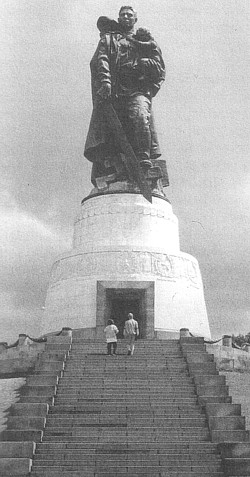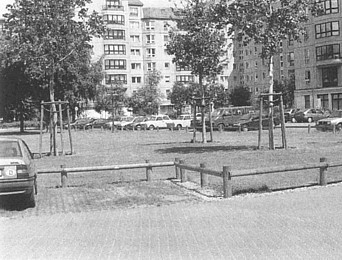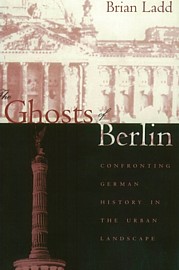Essay (back
to top)
Reflections of the Legacy of Third Reich in
German Consciousness in Physical Berlin
Brian Ladd notes in the introduction to his book, The Ghosts of Berlin:
Confronting German History in the Urban Landscape, that buildings
are "the symbols and repositories of memory" (p.4). With this
as his focus, Ladd examines the history and collective memory of Berlin,
asking what is reflected in and what can be learned from the architectural
decisions and indecisions that have occurred in the city. While focusing
on a range of architectural issues, one of the themes that weaves its
way through the book is the question of coming to terms with the troubled
legacy of the Third Reich since 1945. The examination of the buildings
and sites serves as a starting point for a much wider discussion of the
political, social, and psychological ramifications of this legacy as reflected
in the debates and choices made regarding preservation, the erection of
memorials, and other such questions. It is clear that no single clean-cut
answer exists when it comes to the issue of how to come to terms with
such a troubled past, but in the years following WWII, three main "myths"
surfaced regarding these atrocities: the myth of ignorance, the myth of
resistance, and the myth of victimization. While not explicitly referenced
by Ladd, the presence of these myths in his history is undeniable and
can be seen in the conceptualizations of what should and should not be
done about the physical and architectural legacy of WWII. Taken together,
the myths weave themselves into a net of sorts that separates modern Germany
from fully acknowledging and examining the legacy that was left by the
Third Reich, a separation that is clearly reflected in the plethora of
highly debated architectural issues that continue to emerge.
A further explanation of the exact nature of the three myths is required
in order to understand how each myth presents itself over the course of
the history laid out in Ladd’s book. Germans who ascribed to the myth
of ignorance took the stance that they weren’t aware of exactly what was
happening during WWII, and that when the war came to an end and the truth
was brought to light, they were horrified to learn of the death camps
and the suffering. Over time this mentality transformed into a desire
to move on and to remain unaware of the atrocities. The myth of resistance,
on the other hand, was held by those individuals who felt that, while
they did not know everything, they resisted as much as they could based
on the knowledge that they had. Over time this myth developed into the
mindset that enough is known about WWII, that the physical markers of
the war should be swept away, and that the survivors of the war should
not be emphasized so much. Those who believed the myth of victimization
held that WWII and the Holocaust were not the fault of the entire German
people, but rather that the "good Germans" were victims of "bad
Nazis," which with time became the conceptualization of the Germans
as victims of the Allies (Marcuse, lecture, 1/27/06).
Myth of Resistance

The
Soviet War Memorial at Berlin-Treptow is an example of how the legacy
of communist struggle against the Third Reich was clung to as a
cornerstone of the East German myth of resistance. (Ladd, 195) |
The myth of resistance, while present in both states, took on a distinctly
different flavor in East Germany than it did in West Germany. In East
Germany, those who glorified this myth clung to the resistance of the
Communists who fought against the Nazi party both before and after 1933,
such that this "formed the cornerstone of the German Democratic Republic’s
identity as the antifascist German state" (Ladd, p.149), and allowed
East Germans to reside in a land of "conquering heroes." In
turn, this worked to create the illusion of a break from the legacy of
the Third Reich (Ladd, p.206). One East German monument that clearly attempted
to further the myth of resistance was the Ernst Thälmann memorial,
the biggest monument in East Berlin, which honored the chairman of the
German Communist Party from 1925 to 1933 who was murdered at Buchenwald
in 1944 (Ladd, p.201). Another example of this mentality could be seen
in Treptow at the main Soviet memorial that depicted an oversized soldier
stomping on a swastika, such that the monument formed a "grand expression
of heroism and triumph – a style the GDR’s leaders embraced in the name
of the anti-fascist German state, born of the alliance with Soviet antifascism"
(Ladd, pp.195-196). Here the connection being drawn between Communism
and the struggle against the Nazis served the GDR’s attempt to illustrate
that resistance to the fascist regime existed on the part of citizens
of the GDR and their Nazi-era predecessors, thus aiding to ameliorate
post-WWII guilt.
In West Berlin, the concept of resistance as a myth is tinged with multiple
layers of irony. To begin with, the main heroes of the resistance that
the West had to place on a pedestal were those individuals involved in
the failed attempt to assassinate Hitler on July 20, 1944. This is ironic
in one sense because these people were high-ranking conservatives in the
government and military, who, as Ladd points out, "supported the
Third Reich until it began to lose the war" (p.150). Their positions
and late action do not make most of them resisters so much as opportunists
who were with Hitler while it benefited them, and then wanted him out
of power at least in part because he was losing.
The myth of resistance is also ironic in that the response of the populace
to the early attempts to spread and solidify this myth largely negated
the myth itself. For example, a statue that was dedicated in 1953 to the
attempted assassins at Bendlerblock, where some of the conspirators were
executed, was only given the status of a national memorial to resistance
in 1967 (Ladd, pp.149-150). Clearly the delay in widespread recognition
and adoption of the statue as a national memorial reflected that many
Germans "considered them [the would be assassins] to have been what
Goebbels’ media had portrayed them as: traitors" (Ladd, p.149). If
the indoctrination was so strong among Germans that they continued to
view those who attempted to assassinate Hitler as traitors, how could
the people claim to have resisted? Regardless of the lack of consistency,
the statue erected as a resistance memorial came to serve the myth well,
with a 1972 visitors’ brochure at the memorial stating that, "The
German resistance proves that the entire German people was not stricken
with the disease of totalitarianism and that, in Germany, too, the tradition
of inalienable human rights could not be destroyed" (Ladd. p.150).
This clearly demonstrates the way in which the myth of resistance helped
to ease the minds and clear the consciences of those who ascribed to it.
Myth of Ignorance

The
site of Hitler's bunker, pictured here in 1995, is a clear illustration
of the myth of ignorance with its lack of documentation about its
significance during the Nazi era. (Ladd, 134) |
The reactions of many people, particularly conservatives, to proposals
of preservation and other such markers of the Nazi legacy show how the
myth of resistance transformed from the notion that the German people
resisted as much as they could based on their awareness of Nazi atrocities,
to the mindset that the sites of Nazism and Nazi crimes should be swept
away and that enough is known about the era. This, in turn, works in conjunction
with the development of the myth of ignorance into the mindset that it
is not desirable to know more about the Third Reich. The developments
of these forces clearly come into play in a common reaction to the unearthing
of the bunker in 1990. Ladd points out, "Many people, especially
conservatives, wished to destroy the bunker or cover it up and forget
about it" (Ladd, p.132). As can be seen with what ended up happening
to the Führerbunker, "Typical German treatment of a historically
burdened site, Kernd’l [the head of the municipal archaeology office]
observed sardonically, is either to plant it with greenery or to use it
for parking, and here we have both" (Ladd, p.134). These conscious
attempts to ignore or gloss over the Nazi influence on the city are clear
extensions of these highly influential myths.
Another way in which it is possible to construe that these myths were
and are present in the mindset of Berliners is in the repeatedly expressed
desire and multiple attempts to restore or renovate city architecture
in order to regain the appearance of the pre-Nazi era, typically going
back to before 1914 and the First World War. Examples of this can be seen
in the rebirth, "critical reconstruction," and accompanying
rewriting of the history of the Mietkaserne (the five story tenement buildings
inhabited by all but the richest Berliners by the 1900s, "the preeminent
symbol of Berlin as industrial metropolis," p.100) and Friedrichstadt
(the old commercial center of Berlin). As Ladd puts it, "What had
been the troubling specter of modernity and upheaval is now a comforting
link back to an idealized past" (p.109). Undoubtedly the urge to
move away from the Nazi legacy points to these myths and the way in which
they capture the mindset of a segment of the German population.
Sites that have not received memorial status also serve as examples of
the myth of ignorance at work. Particularly interesting instances of this
are the office buildings previously inhabited by Nazis that simply rolled
over into use during the post-WWII era. Two of the most striking examples
of this ignorance at work can be seen in the fates of the sites of the
Third Reich’s Ministry of Aviation and Ministry of Popular Enlightenment
and Propaganda. The building that housed the Ministry of Aviation during
the Nazi era, having survived WWII fairly unscathed, was renamed the "House
of Ministries" by the GDR. In addition to being a main center of
the East German government throughout the GDR’s existence, the building
housed the ceremony that officially established the GDR in 1949. While
both a mural and a plaque commemorated significant GDR events in the building,
no reference was made to the Nazi planning that occurred within its walls
(Ladd, p.146). Just as troublesome, if not more so, was the smooth transition
that occurred in the buildings of Goebbels’ Ministry of Popular Enlightenment
and Propaganda. The GDR decided to use these existing buildings to house
the Government Press Office and Ministry of Media Policy (Ladd, p.148).
The clear dismissal of the Nazi legacies of these buildings speaks volumes
about the degree to which the myth of ignorance played a role in the East
German consciousness during the post-Nazi era.
Myth of Victimization
The myth of victimization is certainly no less important in the history
of Berlin’s attempts to come to terms with the legacy of the Third Reich,
and in some cases this myth even works in conjunction with the myths of
resistance and ignorance. For example, victimization and resistance work
simultaneously in the irony of the Western myth of resistance. This use
can be construed as an example of how "bad Nazis" thoroughly
indoctrinated "good Germans," such that the influence of the
"bad Nazis" was what caused the delayed the acceptance of the
memorial to the resisters. More concrete ways in which the myth of victimization
can be seen influencing the architectural decisions of the post-Nazi era
include the transition into identifying with the broader category of Nazi
victims that began to occur in West Berlin with the 1952 establishment
of "a memorial to victims of the Hitler dictatorship at the Plötzensee
prison in northwestern Berlin" and its dedication to "all the
millions who had been persecuted or killed because of their ‘political
convictions, religious beliefs, or racial heritage’" (Ladd, pp.152-153).
This tendency to lump all victims together is also evident in the slow
build up of plaques and sculptures that marked where Jews were persecuted
(Ladd, p.152).
While the decisions discussed above show an orientation towards the plight
of victims and subtly highlight the ways in Germans saw themselves as
victims as opposed to perpetrators, the most blatant example of the myth
of victimization can be seen in the debate over a national Holocaust memorial.
Lea Rosh, a television talk-show host, spearheaded the push for a national
Holocaust memorial to honor Jewish victims, stating that Germany needed
to do what other nations had already done in establishing the memorial
(Ladd, pp.168-9). However, in looking at the need for a memorial from
this perspective, Rosh failed to acknowledge that Germany is not like
"other nations," particularly when it comes to the legacy of
the Holocaust. In ignoring this she demonstrated her unwillingness to
see the complex issues involved. Her complete attachment to the myth of
victimization became most apparent in her rejection of placing a memorial
in front of the Reichstag (on which the inscription reads DEM DEUTSCHEN
VOLKE, "To the German People," p.87), stating, "Did the
‘German people’ murder the Jews? Hardly" (Ladd, p.172). This statement
exposes her belief that it was "bad Nazis" as opposed to "good
Germans" who were the perpetrators of the horrors of the Third Reich.
The debate laid out by Ladd ends in 1997, before the erection of the
memorial that was officially opened in May of 2005, so the impact of the
memorial on the psyche of Berliners and the ways in which Berliners chose
to interpret the memorial can now be studied. However, from the point
of view of those examining the issues before resolution, the argument
was made by individuals such as Kernd’l, the head of the municipal archaeology
office, and those involved in the Active Museum, the group behind "The
Topography of Terror" exhibition, that the memorial was an "alibi"
and that placing the memorial on the site proposed by Rosh that was so
closely linked to Hitler would in effect shift the blame onto his shoulders
alone and thus remove the burden from common Germans (Ladd, p.170). These
arguments were seemingly not a problem in the eyes of Rosh. Clearly the
criticism of the concept of a national Holocaust memorial brings to light
the concern of some Germans regarding the application of the myth of victimization.
Beginning in the 1970s, more and more individuals began to advocate the
preservation and examination of Nazi sites that were not consistent with
the tenets of the three myths. A particularly significant example of this
departure is "The Topography of Terror." This exhibition, established
on the site of the Gestapo and SS headquarters by the Active Museum during
the 1980s, is characterized by Ladd as "perhaps the most self-conscious
attempt to uncover the historical legacy of a particular place in Berlin"
(p.154). The combination that was achieved by the Active Museum of preserving
Nazi sites and documenting their use in order to allow for an open and
nuanced look at the Third Reich‘s geographical links to history in Berlin
moved beyond the myth-motivated memorials of its predecessors and showed
the changing consciousness of younger generations of Germans.
It is clear that the three predominant myths regarding the atrocities
of the Third Reich come to the surface in a variety of ways in Ladd’s
examination of the architecture of Berlin and the stories behind the physical
aspects. However, these three myths do not tell the whole story, as evidenced
by the push by some like those involved with the Active Museum who are
dedicated to documentation and preservation. The interweaving of the myths
with other perspectives and opinions demonstrate the difficulty of coming
to a consensus about such a troubled past. What is clear, however, is
that the physical aspects of Berlin and the debates that they inspire
are intimately tied not only the past of the city and the German people,
but to what will become of them as well.
|


